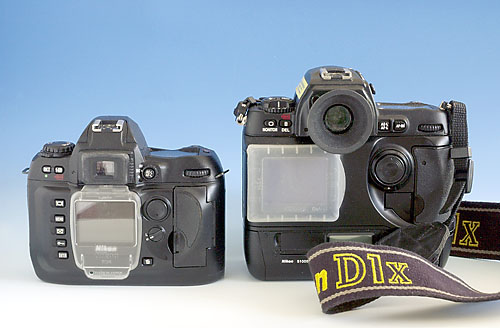 |
|
| The Nikon D100 camera with AFS 24-85 mm f/3.5-4.5G IF-ED lens. © Bjørn Rørslett/NN | |
Let me put things straight from the beginning. The Nikon D100 is slated to become a huge success in terms of sales. It will cause people to rave and rant about the coming of the Digital Age. Even tough, field-hardened pro photographers may soften enough to be endeared by this little marvel.
 |
|
| The Nikon D100 camera with AFS 24-85 mm f/3.5-4.5G IF-ED lens. © Bjørn Rørslett/NN | |
A great deal of the photographic society yearn for digital SLR bodies at affordable prices, yet with offerings of that elusive "pro" digital quality hitherto linked to the expensive likes of Nikon D1X and Canon EOS 1D. With Canon's recent D60 and Nikon's D100, the coming of a Digital Age for everybody is here. Although not cheap, these cameras commence a sales war at a competetive price level, and it's everybody's guess that the customers will benefit in the end.
This review will not describe all the many features of D100 in detail, which by the way are excellently taken care of by Phil Askey at www.dpreview.com. Another, even more thorough review, has been published by Dave Etchell. Suffice to say here that D100 obviously has been stripped of some features found on its professional big brothers, D1X and D1H, but the targeted buyers probably wouldn't know what has been lost. What you don't know won't hurt you, anyway.
My main interest focused on how D100 would handle under realistic field conditions, and what kind of image quality one might squeeze out of this small camera. Looking at the figure below, it is hard to understand that Nikon managed to put all the necessary digital wizardry and circuits into such a small body. Clever tricks, such as having a CF-card slot set at an angle, are used for utilising every nook and cranny within the body.
Largely due to all the printed circuits within and its internal metal framework, D100 feels quite hefty and its weight at 700 g belies its small size. I for one believe this is advantageus by helping to stabilise the camera during shooting. There is the ubiquitous plastic outer casing to satisfy the most plastic-hungry fan, but fortunately an ergonomically shaped body in conjunction with rubberised covers helps make the camera easy to hold and to operate effortlessly. You can easily work D100 with a single hand provided an AFS lens is mounted on it. The likely companion of D100 should be the AFS 24-85 mm f/3.5-4.5 G IF-ED Nikkor (now, do I dislike the long nomenclature of those recent Japanese inventions), which is an excellent performer on its own. Together with this AFS stablemate, D100 balances nicely and the entire outfit is surprisingly compact.
 |
| Set against a professional digital SLR, the D100 shows how small-sized this newcomer really is. Yet both cameras are capable of outputting approx. 6MPix image files. Size counts, but not the way you might expect. © Bjørn Rørslett/NN |
D100 takes a smallish-sized Li-Ion battery which keeps the camera running for a very long time indeed. In fact, I shot hundreds of images and did a lot of scrutinising of them at the LCD display, including zooming into each frame in order to ascertain detail sharpness, and still the battery indicator did not move from its "Full" sign. This performance is simply remarkable for anyone having had to fight against the battery depletion troubles of D1, D1X (and to a lesser extent, D1H) cameras. Needless to say, I liked this power frugality - a lot.
Some aspects of D100's design adversely impact its handling. In particular, I did not find the viewfinder even remotely similar in quality to that of my D1-series cameras. Firstly, the lack of a true eyecup combined with the retracted position of the ocular means you cannot easily put your eye in a comfortable position and concomitantly, there is a danger of straylight and flare when the screen is viewed. People wearing eye-glasses, like me, may have difficulty seeing the entire viewfinder image and flare may impair viewing as well. I guess persons with normal eyesight would face less problems here, but improvements to the finder should be considered. Probably the eye-cup from a F-401/F-601 would fit, but I haven't tried.
Secondly, there is a bright-view groundglass with gridlines on it, as with the "E" screen of F5, F100, and D1-series bodies. A clever trick makes the selected focusing spot and the grid light up red when the shutter release is pressed, however, this also contributes to a further reduction of focusing contrast and I found myself getting increasingly annoyed by this feature after a while. Preferences may vary here and probably many users will regard this as a nice feature, but I for one would prefer a way of switching the light-show off permanently (when the camera manual arrived some weeks later, I found out how using a production D100). I also had some trouble focusing long lenses on the bright screen. There is a sliding lever to set dioptre correction to the right of the ocular, which is fiddly to apply, and I wished for a practical solution like that on my D1X/D1H cameras.
A third potential area for problems is the shutter button. True, it is threaded to accept a cable release, but its action should have been smoother and when using a cable release in conjunction with a long lens, it is entirely possible to jolt the camera sufficently to impact image sharpness. I had several incidents of this kind with 400 and 500 mm lenses, obviously not the kind of glass the targeted user is likely to possess, but nevertheless, the issue is for real.